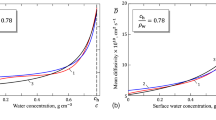Summary
The flux of water across the outer barrier of the frog skin is generally regarded as the rate-limiting step in the movement of water across the whole membrane. This paper presents some evidence that, at room temperature, the flux of water across the outer barrier occurs through water in a non-liquid state. The organization of water in a non-liquid state lowers the diffusion coefficient of water through water by several orders of magnitude. The study employs a method recently developed in this laboratory which permits measurement of unidirectional fluxes at the outermost part of an epithelial membrane mounted as a flat sheet. Only above 25°C is the activation energy for the flow of tritiated water (4.3 kcal mole−1) similar to the one observed in free water (4.6 kcal mole−1). At temperatures around 15°C, the energy of activation is 8.5 kcal mole−1. At temperatures near 0°C, at which the frog lives only part of the year, the energy of activation is 16.7 kcal mole−1.
Similar content being viewed by others
References
Bray, G. A. 1960. Liquid scintillator for aqueous solutions.Analyt. Biochem. 1:279
Chapman, G., McLauglan, K. A. 1967. Oriented water in the sciatic nerve of rabbit.Nature 215:391.
Cope, F. W. 1967. Evidence for complexing of Na+ in muscle, kidney and brain, and by actomyosin. The relation of cellular complexing of Na+ to water structure and to transport kinetics.J. Gen. Physiol. 50:1353.
— 1969. Nuclear magnetic resonance evidence using D2O for structured water in muscle and brain.Biophys. J. 9:303.
Dainty, J., House, C. R. 1966. Unstirred layers in frog skin.J. Physiol. 182:66.
Fedyakin, N. N. 1961. Quoted by B. V. Derjaguin, 1965. Recent research into the propertie of water in thin films and in microcapillaries.Symp. Soc. Exp. Biol. 19:55.
Finean, J. B. 1962. The nature and stability of the plasma membrane.Circulation 26:1151.
Fogg, G. E. 1965. The state and movement of water in living organisms. Symposia of the Society for Experimental Biology. XIX. Cambridge University Press, Cambridge.
Fritz, O. G., Swift, T. J. 1967. The state of water in polarized and depolarized frog nerves. A proton magnetic resonance study.Biophys. J. 7:675.
Hays, R. M. 1968. A new proposal for the action of vasopressin based on studies of a complex synthetic membrane.J. Gen. Physiol. 51:385.
Hays, R. M., Franki, N. 1970. The role of water diffusion in the action of vasopressin.J. Membrane Biol. 2:263.
—, Leaf, A. 1962. The state of water in the isolated toad bladder in the presence and absence of vasopressin.J. Gen. Physiol. 45:933
Helfferich, F. 1962. Ion Exchange. McGraw-Hill, New York.
Hempling, H. G. 1960. Permeability of the Ehrlich ascites tumor cell to water.J. Gen. Physiol. 44:365.
Hinke, J. A. M. 1959. Glass microelectrodes for measuring intracellular activities of sodium and potassium.Nature 184:1257.
House, C. R., Jarvis, P. 1968. Effects of temperature on the radial exchange of labelled water inmaize roots.J. Exp. Bot. 19:31.
Jacobs, M. H., Glassman, H. N., Parpart, A. K. 1935. Osmotic properties of the erythrocyte. VII. The temperature coefficients of certain hemolytic processes.J. Cell. Comp. Physiol. 7:197.
Kidder, G. W., Cereijido, M., Curran, P. F. 1964. Transient changes in electrical potential differences across frog skin.Amer. J. Physiol. 55:267
Kuhn, W., Thürkauf, M. 1958. Isotopentrennung beim Gefrieren von Wasser und Diffusionskonstanten von D und O im Eis.Helv. Chim. Acta 41:938.
Leaf, A., Hays, R. M. 1962. Permeability of the isolated toad bladder to solutes and its modification by vasopressin.J. Gen. Physiol. 45:921.
Ling, G. N. 1969. A new model for the living cell: A summary of the theory and recent experimental evidence in its support.Intern. Rev. Cytol. 26:1.
Lucke, B., McCutcheon, M. 1932. The living cell as an osmotic system and its permeability to water.Physiol. Rev. 12:68.
Luzzati, V. 1968. X-ray diffraction studies of lipid-water systems.In: Biological Membranes. p. 71. D. Chapman, editor. Academic Press, New York.
Machin, J. 1969. Passive water movement through skin of the toadBufo marinus in air and in water.Amer. J. Physiol. 216:1562
McRobbie, E. A. C., Ussing, H. H. 1961. Osmotic behaviour of the epithelial cells of frog skin.Acta Physiol. Scand. 53:348.
Nernst, W. 1904. Theorie der Reaktionsgeschwindigkeit in heterogenen Systemen.Z. Phys. Chem. 47:52.
Nevis, A. H. 1958. Water transport in invertebrate peripheral nerve fivers.J. Gen. Physiol. 41:927.
Noyes, A. A., Whithney, W. R. 1897. Über die Auflösungsgeschwindigkeit von festen Stoffen in ihren eigenen Lösungen.Z. Phys. Chem. 23:689.
Reisin, I. L., Rotunno, C. A., Corchs, L., Kowalewski, V., Cereijido, M. 1970. The state of sodium in epithelial tissues as studied by nuclear magnetic resonance.Physiol. Chem. Phys. 2:171.
Rotunno, C. A., Kowalewski, V., Cereijido, M. 1967. Nuclear spin resonance evidence for complexing of sodium in frog skin.Biochim. Biophys. Acta 135:170.
—, Vilallonga, F., Fernández, M., Cereijido, M. 1970. The penetration of sodium into the epithelium of the frog skin.J. Gen. Physiol. 55:716.
Schmitt, F. O., Bear, R. S., Ponder, E.: Optical properties of the red cell membrane.J. Cell. Comp. Physiol. 9:89.
Vieira, F. L., Sha'afi, R. I., Solomon, A. K. 1970. The state of water in human and dog red cell membranes.J. Gen. Physiol. 55:451.
Wang, J. H., Robinson, C. V., Edelman, I. S. 1953. Self-diffusion and structure of liquid water. III. Measurement of the self-diffusion of liquid water with H2, H3 and O18 as tracers.J. Amer. Chem. Soc. 75:466.
Whipple, H. E. 1965. Forms of water in biologic systems.Ann. N. Y. Acad. Sci. 125:249.
Widdas, W. F. 1951. Changing osmotic properties of foetal sheep erythrocytes and their comparison with those of maternal sheep erythrocytes.J. Physiol. 113:399.
Author information
Authors and Affiliations
Rights and permissions
About this article
Cite this article
Grigera, J.R., Cereijido, M. The state of water in the outer barrier of the isolated frog skin. J. Membrain Biol. 4, 148–155 (1971). https://doi.org/10.1007/BF02431967
Received:
Issue Date:
DOI: https://doi.org/10.1007/BF02431967




